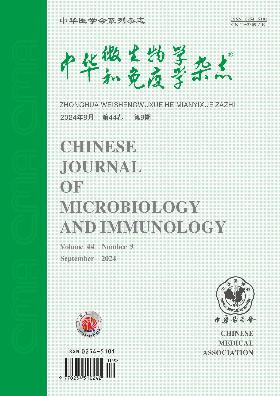Analysis on serotypes and antibiotic resistance characteristics of food-borne Salmonella strains in Guizhou Province from 2016 to 2018
Q4 Immunology and Microbiology
引用次数: 3
Abstract
Objective To analyze the serotype distribution and antibiotic resistance characteristics of food-borne Salmonella strains isolated from food and patients with gastroenteritis in Guizhou Province from 2016 to 2018. Methods Serotypes of the strains were characterised using slid agglutination method with Salmonella antisera. Minimal inhibitory concentrations (MIC) of antibiotics were determined by the broth microdilution method. Microsoft Excel 2007 and SPSS18.0 were used for statistical analysis. Results A total of 170 strains of food-borne Salmonella were detected in food and patients with gastroenteritis in Guizhou Province from 2016 to 2018. Thirty-five serotypes were identified and 6 were found in both food and patients. The main serotypes in food were Salmonella Typhimurium (16.67%) and Salmonella Stanley (8.33%), and the predominant serotypes in patients were Salmonella Typhimurium (41.79%), Salmonella Enteritidis (16.42%) and Salmonella London (8.96%). The rate of resistance to ampicillin, chloramphenicol, tetracycline, ciprofloxacin, nalidixic and trimeth-sulfame were 27.78%-33.33% among the isolates from food, and 22.22%-25.00% to gentamicin, cefocime and ampicillin/sulbatan. Among the isolates from patients, the highest resistance was to ampicillin (55.97%), followed by that to tetracycline (49.25%), ampicillin/sulbatan (44.03%), nalidixic acid (41.04%) and cefazolin (37.31%), and 20.90%-30.60% strains were resistant to chloramphenicol, ciprofloxacin, gentamicin, cefotaxime and ampicillin/sulbatan. There were 25.00% isolates from food and 25.37% isolates from patients resistant to at least 6 antibiotics, and the main multi-resistant pattern was ampicillin-tetracyline-nalidixic-cephalosporin antibiotics (partial). Conclusions There were many kinds of serotypes of food-borne Salmonella in Guizhou Province from 2016 to 2018 and the predominant types were Salmonella Typhimurium, Salmonella Enteritidis and Salmonella London. Drug resistance was common in the strars and some multidrug resistant strains were detected. Key words: Food-borne Salmonella; Serotype; Drug resistance2016 - 2018年贵州省食源性沙门氏菌血清型及耐药特征分析
目的分析2016~2018年贵州省胃肠炎患者和食品中分离的食源性沙门氏菌的血清型分布及耐药性特征。方法采用滑动凝集法和沙门氏菌血清进行血清学鉴定。采用肉汤微量稀释法测定抗生素的最小抑菌浓度。采用Microsoft Excel 2007和SPSS18.0软件进行统计分析。结果2016年至2018年,贵州省胃肠炎患者和食品中共检出170株食源性沙门氏菌。共鉴定出35种血清型,在食物和患者中均发现6种。食物中的主要血清型为鼠伤寒沙门氏菌(16.67%)和斯坦利沙门氏菌,食品分离株中萘啶和磺胺三甲胺的检出率分别为27.78%-33.33%和22.22%-25.00%。在患者分离株中,对氨苄青霉素的耐药性最高(55.97%),其次是四环素(49.25%)、氨苄青霉素/舒巴坦(44.03%)、萘啶酸(41.04%)和头孢唑林(37.31%),对氯霉素、环丙沙星、庆大霉素、头孢噻肟和氨苄青霉素-舒巴坦的耐药性为20.90%-30.60%。对至少6种抗生素有25.00%的食物分离株和25.37%的患者分离株耐药,主要的多重耐药模式是氨苄青霉素-四缸萘啶-头孢菌素类抗生素(部分)。结论2016~2018年贵州省食源性沙门氏菌血清型较多,以鼠伤寒沙门氏菌、肠炎沙门氏菌和伦敦沙门氏菌为主。耐药菌株在strars中普遍存在,并检测到一些多药耐药菌株。关键词:食源性沙门氏菌;血清型;耐药性
本文章由计算机程序翻译,如有差异,请以英文原文为准。
求助全文
约1分钟内获得全文
求助全文
来源期刊

中华微生物学和免疫学杂志
Immunology and Microbiology-Virology
CiteScore
0.50
自引率
0.00%
发文量
6906
期刊介绍:
Chinese Journal of Microbiology and Immunology established in 1981. It is one of the series of journal sponsored by Chinese Medical Association. The aim of this journal is to spread and exchange the scientific achievements and practical experience in order to promote the development of medical microbiology and immunology. Its main contents comprise academic thesis, brief reports, reviews, summaries, news of meetings, book reviews and trends of home and abroad in this field. The distinguishing feature of the journal is to give the priority to the reports on the research of basic theory, and take account of the reports on clinical and practical skills.
 求助内容:
求助内容: 应助结果提醒方式:
应助结果提醒方式:


